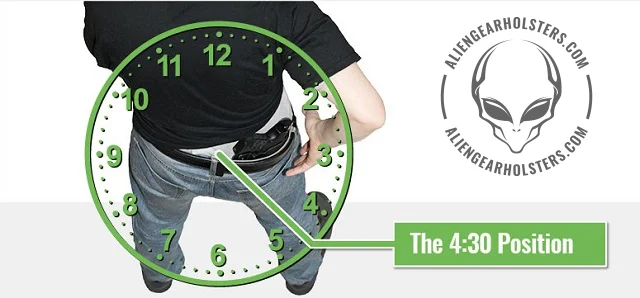
Best Holster For When You Have To Tuck In Your Shirt
Not all of us like to have long, droopy clothing that hangs loose. Some people like to dress up, wear a nice button-up shirt, and maybe some good slacks. For those of you that do, you may have been traditionally stuck either carrying outside the waistband or wrapping your dress shirt over and around an inside the waistband concealed carry holster that clips directly onto your gun belt.
Good news – there's easy solutions to this. You can stay concealed AND tuck in your dress shirt without any worry. The big element you have to pay attention to is the belt clip. Inside the waistband holsters that clip directly from holster to belt don't allow you to tuck your shirt between the two. If you see a belt clip that hooks up like an upside down letter “J”, you have the ability to tuck down into the space between the clip and the holster. But that's where carrying with a tucked-in shirt begins.
Cloak Tuck Belt Clips: Why Two Is Better Than One

When you're tucking in your shirt into your trousers, wrapping into a single cloak tuck belt clip is convenient – but at what cost? A single point of contact between belt and holster is also a single point of failure. It may also bunch up throughout the course of repeatedly sitting and standing.
Having two belt clips that allow you to tuck in your dress shirt is far better. This enables you to smooth out the profile of your handgun in its inside the waistband holster. Add a suit coat over the top and you are good to go throughout the day.
What's The Best Position For A Tucked In IWB?

This is a question we get asked pretty often. The Cloak Tuck iwb holster series was made to be tucked beneath a polo or dress shirt. As such, different users may find different degrees of concealment depending upon where they position the holster.
In general, we usually recommend starting off at a standard 3 o'clock position on the waistline. This is a good general place to start. Tuck in your shirt and look at yourself in the mirror. If the outline of your gun is clearly visible or stands out prominently, try moving the holster back to 4 o'clock or, conversely, forward to 2 o'clock.
The good news is that with an IWB with a neoprene backpad, no matter where you decide to tuck in, it's always going to be a comfortable fit. The backpad helps distribute the weight of the firearm evenly across the waistline.
How to use an IWB Holster
When looking for the ideal position for your tucked-in IWB holster, look for flat contours in your waistline. This is the best way to add an additional inch or two of width to your waistline without attracting as much attention. Again, depending upon the gun you use, some models will fit more flush with the waistline than others. Just stay patient and definitely consider adding a sweater, jacket, or suit coat over top.
Since the shirt is tucked behind the waistband and belt, it's harder to get it out of the way compared to wearing an untucked shirt over your concealed carry gun and holster or a cover garment like a jacket. Untucked shirts are rather easy to clear; you basically move them out of the way.
A tucked shirt can get a little trickier. Not by too much, but by a bit. Therefore, make sure that you train for clearing the cover garment on a regular basis.
Drawing From A Concealed Carry Holster Behind A Tucked Shirt
If your concealed carry holster is concealed in this manner, there are some techniques for clearing the cover garment.
Watch the following clip for a good idea:
The grip must be strong; you have to rip the shirt clear of the holster to get onto the grip. When you clear the cover garment, it has to fully clear the pistol. If clearing the cover garment with one hand, grasp your shirt near the holster. If possible, use your support hand as an assist.
Much of the literature about the draw stroke suggests the support hand is supposed to be used to clear cover garments. There are some caveats, though. Not all people carry their pistol in a location easily accessed by the support hand. Also, that presumes you'd have use of that arm to begin with; most defensive shootings occur within a few feet so that's not an assumption you should necessarily make.
Therefore, make sure you train to clear your cover garment one-handed.
Grasping the cover garment near the holster is essential. Since the shirt is held in place by some tension from being tucked behind the belt and waistband, you can't move as much of the shirt as you could with one that wasn't tucked.
Wherever on the waistband you carry your pistol, make sure to train the draw. The more you've trained for it, the more you can rely on muscle memory should the moment you need to use it ever arise.
 |
About The Author James England (@sir_jim_england) is the contributing editor for Alien Gear Holsters. He is a veteran of Operation Iraqi Freedom and private defense contracting in Afghanistan. |









